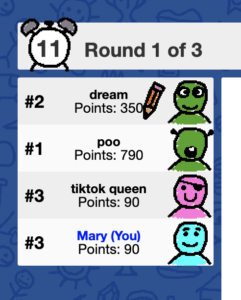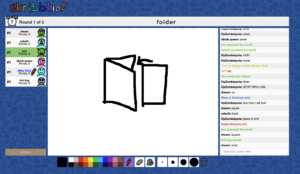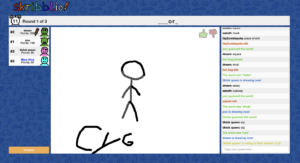
Background Information
Skribbl.io is an online multi-player drawing and guessing game.
Creator:@ticedev
Link to game: https://skribbl.io/
Formal Elements of the Game
1. Players
Each game room can hold 2-8 players at a time. The players interact in multilateral competition; each round of the game consists of an individual who must draw their chosen word while the other players compete against each other to guess what the word is. Players can easily drop in and out of the game while turns and rounds are taking place (although players who join late will be at a score disadvantage).

2. Objectives
There is one overarching objective in this game, which is to earn the most points possible. Additionally, there are two smaller objectives in this game that depend on what role the player is currently taking on.
Drawing player: The objective is to draw the chosen word in a way that is as easily decipherable by the other players as possible, as having the word guessed quickly awards the drawer more points.

Guessing players: The objective is to guess the word represented by the drawing created by the drawing player as quickly as possible, as guessing the word more quickly awards the guessing player more points.

3. Outcomes
First, I will talk about the outcomes that may result from each turn.
- If all guessing players are able to determine the word before the timer runs out, the round is ended early.
- If only some guessing players are able to determine the word before time is up, then some players earn points while others do not.
- If no guessing players are able to determine the word by the time limit, no one earns points.
The outcome that results from the end of the game is a numerical ranking of players based on the points they earned through the rounds of the game.
4. Resources
The following resources are required for playing this game:
- Computer or other device with internet capabilities
- skribbl.io game link
Within the game:
- Timer
- Basic drawing tools + eraser
- Text box to type in guesses
- Ability to view others’ guesses
- Ability to vote to kick players out of the game

5. Rules
The following are the rules taken from the website under “How to Play”:
“When its your turn to draw, you will have to choose a word from three options and visualize that word in 80 seconds, alternatively when somebody else is drawing you have to type your guess into the chat to gain points, be quick, the earlier you guess a word the more points you get!”
6. Procedure
The following is a paragraph that describes how the game flows, also taken from the website under “About”:
“One game consists of a few rounds in which every round someone has to draw their chosen word and others have to guess it to gain points! The person with themost points at the end of game will then be crowned as the winner!”
7. Boundaries
The following are boundaries of the game:
- The timer that limits each turn to 80 seconds of drawing and guessing
- The three word options that the drawing player is presented with and must choose from at the start of their turn
- Only 8 players per game room
- The “hangman”-like hints given to guessing players as time runs out
- The virtual drawing tools that the drawer must use to depict the word
- Only a certain number of (customizable) rounds per game (default is 3)
- If other players do not enjoy the presence of a certain player, they can vote to kick them out

Aesthetics of Fun
The following are aesthetics of fun that are embodied by this game:
- Fellowship – especially when this game is played over a video conferencing platform like Zoom, the game serves effectively as a social framework. In terms of formal elements, the simple artistic resources allotted to players give them ample opportunity to laugh at the sometimes ridiculous drawings created by the drawer. The resource that enables players to see others’ guesses allows them to laugh at the often ridiculous attempts. The humor embedded in this game is a great way to increase camaraderie among friends.
- Expression – the drawing player expresses what the chosen word looks like in their mind’s eye through digital sketching. Likewise, players express their way of interpreting the world by guessing the drawer’s word. In terms of formal elements, the primitive digital drawing tools enable players in both instances to discover a little more about themselves and how they think and process things visually.
- Challenge – all players compete against each other as they challenge one another to determine who is best at expressing themselves and understanding others’ expressions. This aesthetic of fun is enabled by the formal element of how players are pitted against each other in multilateral competition.
What can be improved?
I played the game both online with strangers and over video call with friends, and found the video call experience to be more fun and interactive. However, one thing I noticed was that the call had to be set up independently on a video conferencing platform. I think this game could be improved if there was a built-in webcam and microphone setting to mitigate this additional step.
Another way this game could be improved is if the vocabulary could be updated with more interesting words. One of my friends has played this game so many times that he basically knew all the words in the corpus. It would be super interesting if proper nouns (like names of famous people) were thrown in the mix, or if monthly word updates could get rolled out.


